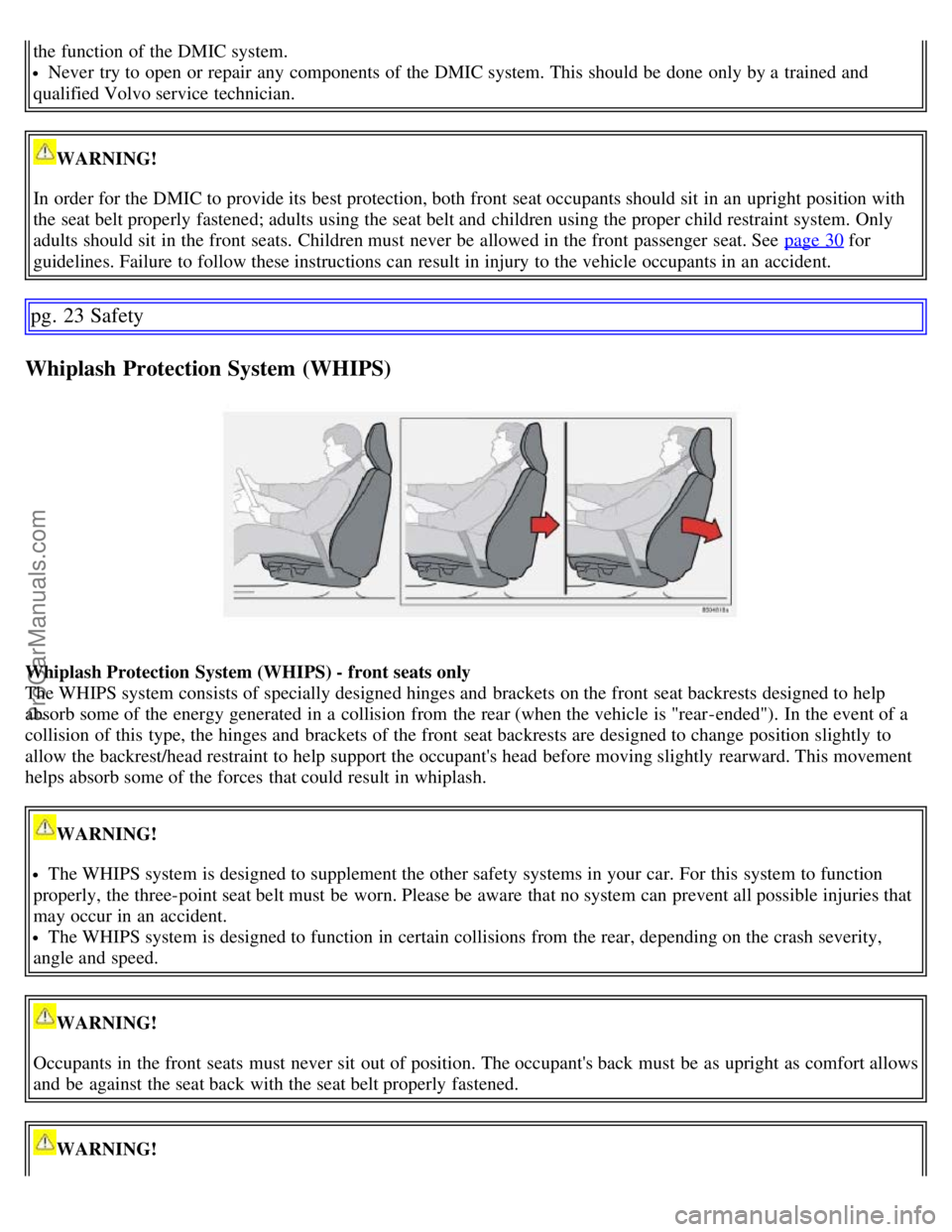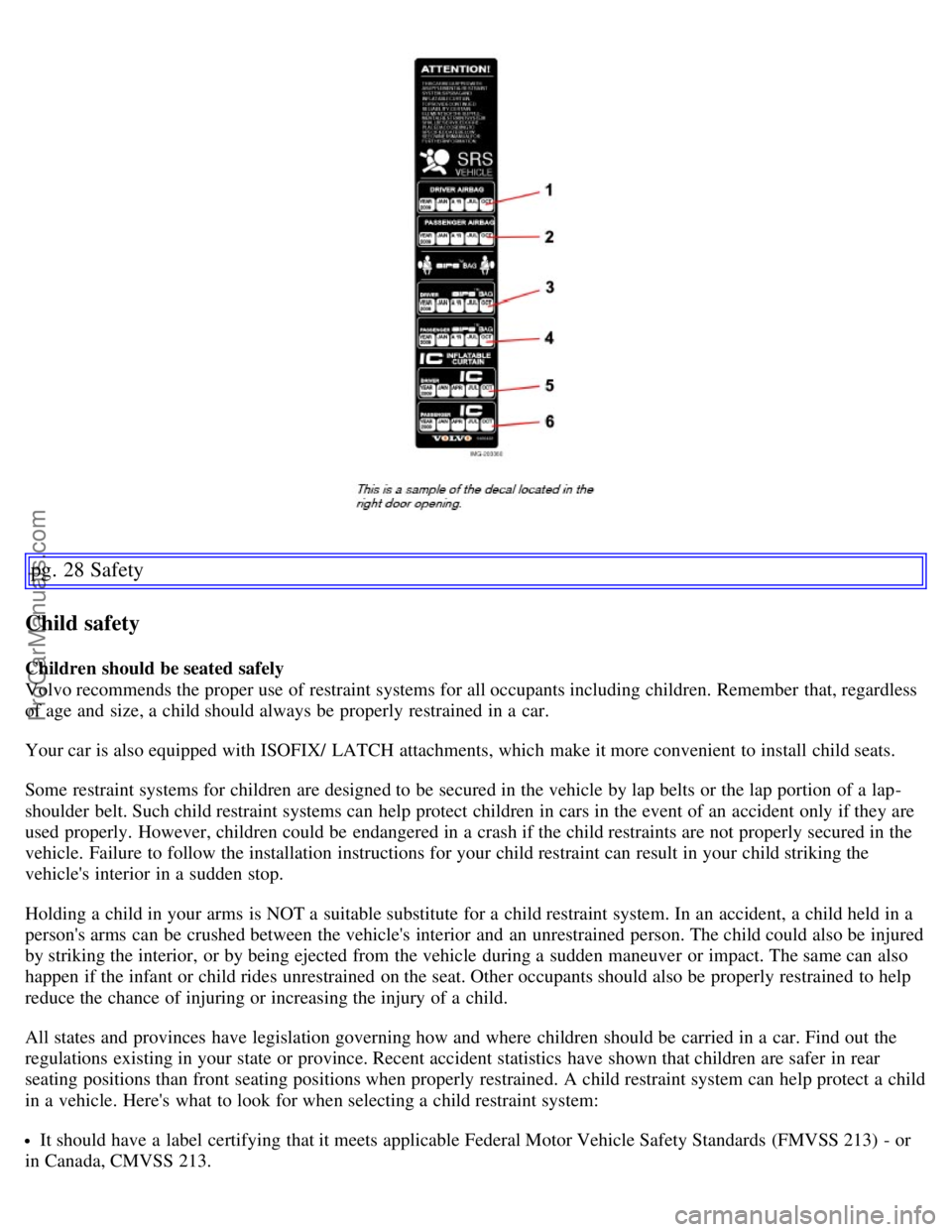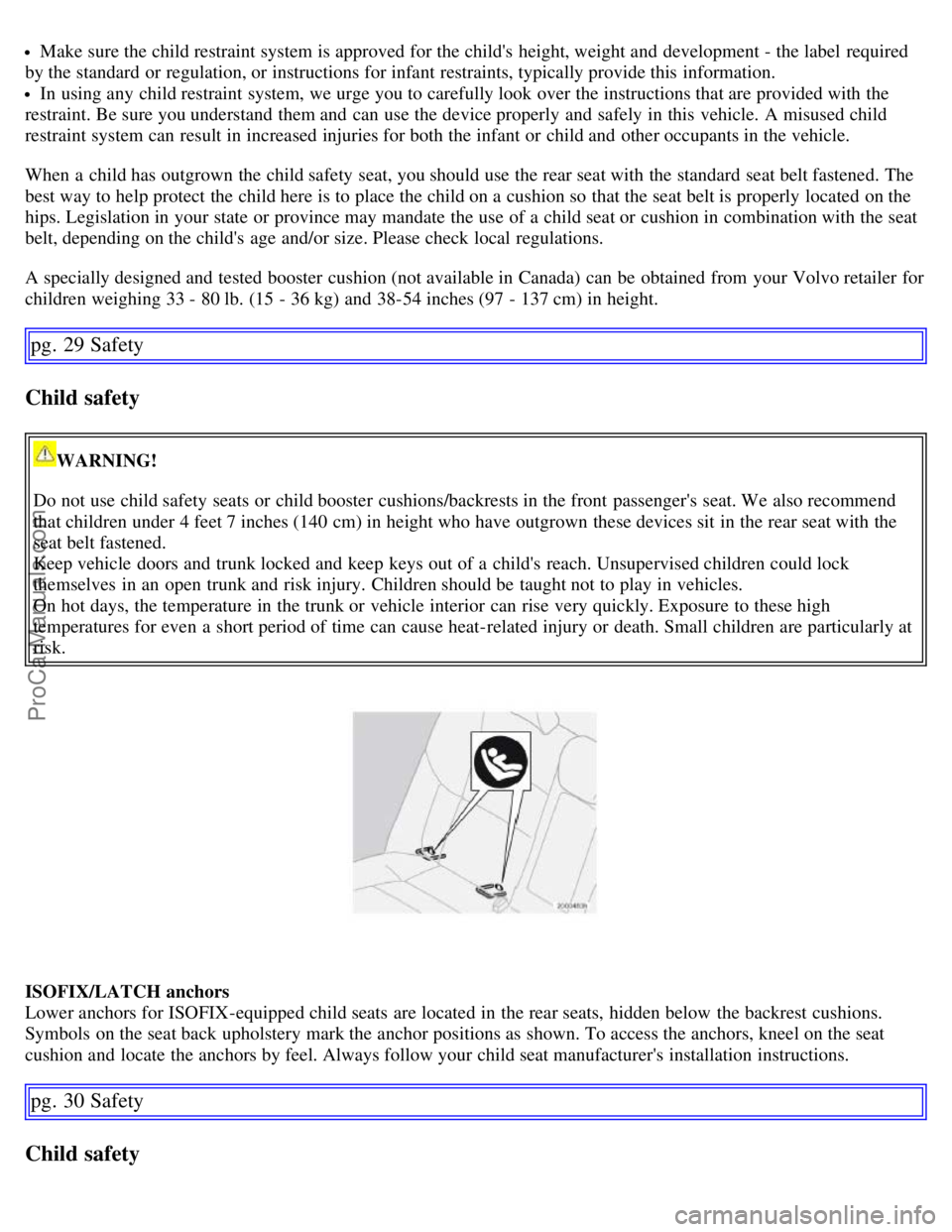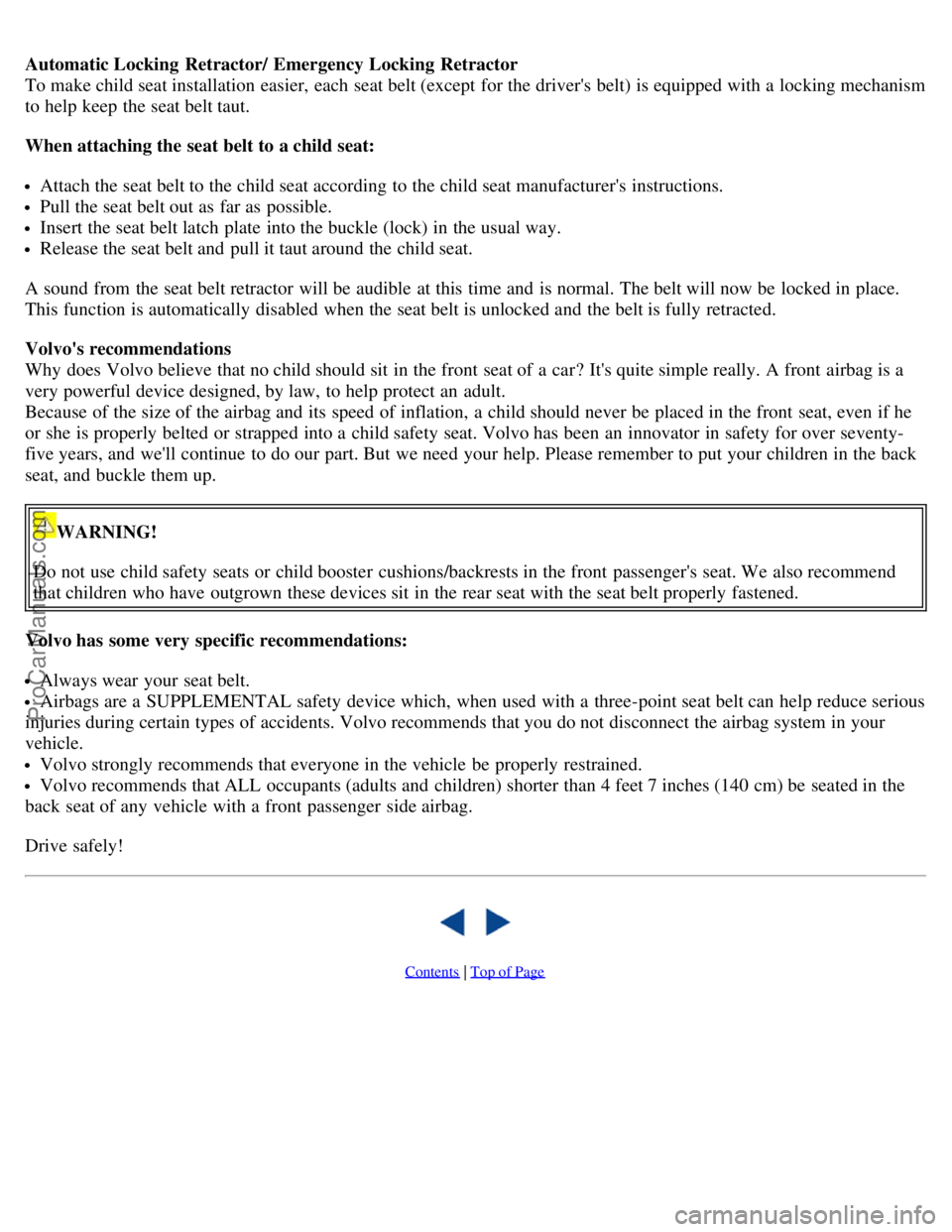VOLVO C70 2006 Owner's Manual
Manufacturer: VOLVO, Model Year: 2006, Model line: C70, Model: VOLVO C70 2006Pages: 182, PDF Size: 3.35 MB
Page 21 of 182

Failure to follow these instructions can result in injury to the occupants of the vehicle in the event of an accident.
pg. 22 Safety
Door Mounted Inflatable Curtain (DMIC)
The Door Mounted Inflatable Curtain system
The DMIC is a supplement to the structural side impact protection. These inflatable curtains are concealed in the upper
section of the driver and passenger doors.
The Inflatable Curtain (DMIC) and the Side Impact Airbag System (SIPS-bag) will both deploy in certain side
impacts.
In certain situations in which there is a roll-over risk, only the inflatable curtain (DMIC) may deploy.
NOTE:
DMIC deployment can occur regardless of whether the power retractable hard top is up or down.
If the inflatable curtain deploys, it remains inflated for approximately 5 seconds.
WARNING!
The DMIC system is a supplement to the Side Impact Protection System. It is not designed to deploy during
collisions from the front or rear of the car. It only provides protection for the occupants of the front seats.
Never install or mount any equipment on the insides of the doors, door pillars, or side panels. This could impede
ProCarManuals.com
Page 22 of 182

the function of the DMIC system.
Never try to open or repair any components of the DMIC system. This should be done only by a trained and
qualified Volvo service technician.
WARNING!
In order for the DMIC to provide its best protection, both front seat occupants should sit in an upright position with
the seat belt properly fastened; adults using the seat belt and children using the proper child restraint system. Only
adults should sit in the front seats. Children must never be allowed in the front passenger seat. See page 30
for
guidelines. Failure to follow these instructions can result in injury to the vehicle occupants in an accident.
pg. 23 Safety
Whiplash Protection System (WHIPS)
Whiplash Protection System (WHIPS) - front seats only
The WHIPS system consists of specially designed hinges and brackets on the front seat backrests designed to help
absorb some of the energy generated in a collision from the rear (when the vehicle is "rear-ended"). In the event of a
collision of this type, the hinges and brackets of the front seat backrests are designed to change position slightly to
allow the backrest/head restraint to help support the occupant's head before moving slightly rearward. This movement
helps absorb some of the forces that could result in whiplash.
WARNING!
The WHIPS system is designed to supplement the other safety systems in your car. For this system to function
properly, the three-point seat belt must be worn. Please be aware that no system can prevent all possible injuries that
may occur in an accident.
The WHIPS system is designed to function in certain collisions from the rear, depending on the crash severity,
angle and speed.
WARNING!
Occupants in the front seats must never sit out of position. The occupant's back must be as upright as comfort allows
and be against the seat back with the seat belt properly fastened.
WARNING!
ProCarManuals.com
Page 23 of 182

If your car has been involved in a rearend collision, the front seat backrests must be inspected by a trained and
qualified Volvo service technician, even if the seats appear to be undamaged. Certain components in the WHIPS
system may need to be replaced.
Do not attempt to service any component in the WHIPS system yourself.
pg. 24 Safety
Whiplash Protection System (WHIPS)
WARNING!
Boxes, suitcases, etc. wedged behind the front seats could impede the function of the WHIPS system.
pg. 25 Safety
Roll-over Protection system (ROPS)
Roll-over Protection system (ROPS)
The ROPS system consists of two roll bars located behind the rear seat head restraints, and a sensor that monitors the
roll or pitch angle of the car.
If the car rolls or pitches beyond a preset angle, the roll bars are automatically deployed (raised).
ProCarManuals.com
Page 24 of 182

NOTE:
The ROPS system is designed to function regardless of whether the power retractable hard top is up or down. By
design, the tops of the roll bars are equipped with a point in order to pierce the rear window if the top is up.
If ROPS has deployed, the system should be inspected and repaired if necessary by a trained and qualified Volvo
service technician.
WARNING!
The rear seat of the Volvo C70 is intended for two occupants, and only two rear seat belts are provided. The center
section of the seat should never be used to seat a passenger.
No objects should be placed over the roll bars or behind the rear seat head restraints.
All repairs or maintenance to the ROPS system should only be performed by a trained Volvo service technician.
pg. 26 Safety
Collision status
Driving after a collision
If the car has been involved in a collision, the text CRASH STATUS SEE MANUAL may appear in the information
display. This indicates that the car's functionality has been reduced.
NOTE: This text can only be shown if the display is undamaged and the car's electrical system is intact.
COLLISION STATUS is a feature that is triggered if one or more of the safety systems (e.g. front or side airbags, an
inflatable curtain, or one or more of the seat belt tensioners) has deployed. The collision may have damaged an
important function in the car, such as the fuel lines, sensors for one of the safety systems, the brake system, etc.
WARNING!
Never attempt to repair the car yourself or to reset the electrical system after the car has displayed CRASH
STATUS SEE MANUAL. This could result in injury or improper system function.
Restoring the car to normal operating status should only be done by a trained and qualified Volvo service
technician.
After CRASH STATUS SEE MANUAL has been displayed, if you detect the odor of fuel vapor, or see any signs
of fuel leakage, do not attempt to start the car. Leave the car immediately.
ProCarManuals.com
Page 25 of 182

Attempting to start the car
If damage to the car is minor and there is no fuel leakage, you may attempt to start the car. To do so:
Remove the ignition key.
Reinsert the key in the ignition switch. The car will then attempt to reset COLLISION STATUS to normal status.
Try to start the car.
Moving the car
If the electrical system is able to reset system status to normal (CRASH STATUS SEE MANUAL will no longer be
shown in the display), the car may be moved carefully from its present position, if for example, it is blocking traffic. It
should, however, not be moved farther than is absolutely necessary.
WARNING!
Even if the car appears to be drivable after COLLISION STATUS has been set, it should not be driven or towed
(pulled by another vehicle). There may be concealed damage that could make it difficult or impossible to control.
The car should be transported on a flatbed tow truck to a trained and qualified Volvo service technician for
inspection/repairs.
pg. 27 Safety
Inspecting SRS system components
Inspection date
1. Driver's side airbag
2. Passenger's side airbag
3. Side airbag on the driver's side
4. Side airbag on the passenger's side
5. Driver's side inflatable curtain
6. Passenger's side inflatable curtain
WARNING!
There is no owner maintenance that can be performed on the SRS system. The month and year shown on the decal to
the right (located on door pillar) indicate when you should contact your Volvo retailer for specific servicing or
replacement of airbag system components. This service must be performed by a trained and qualified Volvo service
technician.
ProCarManuals.com
Page 26 of 182

pg. 28 Safety
Child safety
Children should be seated safely
Volvo recommends the proper use of restraint systems for all occupants including children. Remember that, regardless
of age and size, a child should always be properly restrained in a car.
Your car is also equipped with ISOFIX/ LATCH attachments, which make it more convenient to install child seats.
Some restraint systems for children are designed to be secured in the vehicle by lap belts or the lap portion of a lap-
shoulder belt. Such child restraint systems can help protect children in cars in the event of an accident only if they are
used properly. However, children could be endangered in a crash if the child restraints are not properly secured in the
vehicle. Failure to follow the installation instructions for your child restraint can result in your child striking the
vehicle's interior in a sudden stop.
Holding a child in your arms is NOT a suitable substitute for a child restraint system. In an accident, a child held in a
person's arms can be crushed between the vehicle's interior and an unrestrained person. The child could also be injured
by striking the interior, or by being ejected from the vehicle during a sudden maneuver or impact. The same can also
happen if the infant or child rides unrestrained on the seat. Other occupants should also be properly restrained to help
reduce the chance of injuring or increasing the injury of a child.
All states and provinces have legislation governing how and where children should be carried in a car. Find out the
regulations existing in your state or province. Recent accident statistics have shown that children are safer in rear
seating positions than front seating positions when properly restrained. A child restraint system can help protect a child
in a vehicle. Here's what to look for when selecting a child restraint system:
It should have a label certifying that it meets applicable Federal Motor Vehicle Safety Standards (FMVSS 213) - or
in Canada, CMVSS 213.
ProCarManuals.com
Page 27 of 182

Make sure the child restraint system is approved for the child's height, weight and development - the label required
by the standard or regulation, or instructions for infant restraints, typically provide this information.
In using any child restraint system, we urge you to carefully look over the instructions that are provided with the
restraint. Be sure you understand them and can use the device properly and safely in this vehicle. A misused child
restraint system can result in increased injuries for both the infant or child and other occupants in the vehicle.
When a child has outgrown the child safety seat, you should use the rear seat with the standard seat belt fastened. The
best way to help protect the child here is to place the child on a cushion so that the seat belt is properly located on the
hips. Legislation in your state or province may mandate the use of a child seat or cushion in combination with the seat
belt, depending on the child's age and/or size. Please check local regulations.
A specially designed and tested booster cushion (not available in Canada) can be obtained from your Volvo retailer for
children weighing 33 - 80 lb. (15 - 36 kg) and 38-54 inches (97 - 137 cm) in height.
pg. 29 Safety
Child safety
WARNING!
Do not use child safety seats or child booster cushions/backrests in the front passenger's seat. We also recommend
that children under 4 feet 7 inches (140 cm) in height who have outgrown these devices sit in the rear seat with the
seat belt fastened.
Keep vehicle doors and trunk locked and keep keys out of a child's reach. Unsupervised children could lock
themselves in an open trunk and risk injury. Children should be taught not to play in vehicles.
On hot days, the temperature in the trunk or vehicle interior can rise very quickly. Exposure to these high
temperatures for even a short period of time can cause heat-related injury or death. Small children are particularly at
risk.
ISOFIX/LATCH anchors
Lower anchors for ISOFIX-equipped child seats are located in the rear seats, hidden below the backrest cushions.
Symbols on the seat back upholstery mark the anchor positions as shown. To access the anchors, kneel on the seat
cushion and locate the anchors by feel. Always follow your child seat manufacturer's installation instructions.
pg. 30 Safety
Child safety
ProCarManuals.com
Page 28 of 182

Automatic Locking Retractor/ Emergency Locking Retractor
To make child seat installation easier, each seat belt (except for the driver's belt) is equipped with a locking mechanism
to help keep the seat belt taut.
When attaching the seat belt to a child seat:
Attach the seat belt to the child seat according to the child seat manufacturer's instructions.
Pull the seat belt out as far as possible.
Insert the seat belt latch plate into the buckle (lock) in the usual way.
Release the seat belt and pull it taut around the child seat.
A sound from the seat belt retractor will be audible at this time and is normal. The belt will now be locked in place.
This function is automatically disabled when the seat belt is unlocked and the belt is fully retracted.
Volvo's recommendations
Why does Volvo believe that no child should sit in the front seat of a car? It's quite simple really. A front airbag is a
very powerful device designed, by law, to help protect an adult.
Because of the size of the airbag and its speed of inflation, a child should never be placed in the front seat, even if he
or she is properly belted or strapped into a child safety seat. Volvo has been an innovator in safety for over seventy-
five years, and we'll continue to do our part. But we need your help. Please remember to put your children in the back
seat, and buckle them up.
WARNING!
Do not use child safety seats or child booster cushions/backrests in the front passenger's seat. We also recommend
that children who have outgrown these devices sit in the rear seat with the seat belt properly fastened.
Volvo has some very specific recommendations:
Always wear your seat belt.
Airbags are a SUPPLEMENTAL safety device which, when used with a three-point seat belt can help reduce serious
injuries during certain types of accidents. Volvo recommends that you do not disconnect the airbag system in your
vehicle.
Volvo strongly recommends that everyone in the vehicle be properly restrained.
Volvo recommends that ALL occupants (adults and children) shorter than 4 feet 7 inches (140 cm) be seated in the
back seat of any vehicle with a front passenger side airbag.
Drive safely!
Contents | Top of Page
ProCarManuals.com
Page 29 of 182

2 0 0 6
VOLVO C70
Chapter 3 - Instruments and controls
pg. 31 Instruments and controls
Instrument panel 32
Indicator and warning symbols33
Symbols on the left side of the instrument panel34
Symbols on the right side of the instrument panel35
Symbols on the center of the instrument panel36
Information display37
Lighting panel38
Manually unlocking the fuel filler door39
Left-side steering wheel lever40
Trip computer41
Cruise control42
Right-side steering wheel lever44
Rain sensor45
Steering wheel adjustment, Hazard warning flashers46
Parking brake, 12 volt sockets47
Power windows48
Mirrors49
Personal settings51
Home Link® Universal Transceiver (option)53
pg. 32 Instruments and controls
Instrument panel
ProCarManuals.com
Page 30 of 182

1. Speedometer
2. Turn signal, left
3. Warning symbol
See the next page for additional information.
4. Information display
The display presents information and warning messages, the ambient temperature, and the clock, etc. When the
ambient temperature is between 23° and 36°F (-5° and +2°C), a snowflake symbol is shown in the display. This
symbol serves as a warning for possible slippery road surfaces. Please note that this symbol does not indicate a fault
with your car. At low speeds, or when the car is not moving, the temperature readings may be slightly higher than the
actual ambient temperature.
5. Information symbol
See the next page for additional information.
6. Turn signal, right
7. Tachometer
The tachometer shows engine speed in thousands of revolutions per minute (rpm). Do not drive continuously with the
needle in the red area of the dial, which indicates maximum allowable engine rpm range. Instead, shift to a higher gear
or slow the vehicle down. The engine management system will automatically prevent excessively high engines speeds.
This will be noticeable as a pronounced unevenness in engine speed.
8. Indicator and warning symbols
9. Fuel gauge
The fuel tank holds approximately 16.3 US gallons (62 liters). When a warning light in the gauge comes on, there are
approximately 2.1 US gallons (8 liters) of fuel remaining in the tank.
10. Trip odometer reset button
The trip odometers are used to measure short distances. Press the button briefly to switch between the odometer for the
car's total mileage and the two trip odometers, T1 and T2. A long press (more than 2 seconds) resets the currently
selected trip odometer.
11. Function display
This window displays information on functions such as the odometer, trip odometers, optional rain sensor, and cruise
control.
12. High beam indicator
ProCarManuals.com